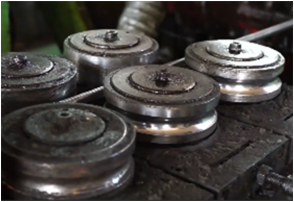ডিসে. . 03, 2024 22:21 Back to list
Innovative Applications of Hot Rolled Thread Bars in Construction and Engineering Projects
Understanding Hot Rolled Thread Bars Applications and Benefits
Hot rolled thread bars are essential components in modern construction and civil engineering, offering a unique combination of strength, versatility, and reliability. These bars, often made from high-grade steel, are characterized by their threaded surface, which provides enhanced bonding capabilities in loaded applications. This article delves into the properties, production process, applications, and advantages of hot rolled thread bars.
Properties of Hot Rolled Thread Bars
Hot rolled thread bars are produced by heating steel billets to a specified temperature, followed by rolling them into the desired shape while maintaining the structural integrity of the steel. The hot rolling process results in a uniform finish, improved strength, and excellent ductility, making these bars ideal for a variety of structural applications.
The most common steel grades used for manufacturing hot rolled thread bars include high-strength low-alloy (HSLA) steels, which exhibit superior mechanical properties, including high yield strength and fatigue resistance. The threaded profile of these bars provides additional benefits, such as improved load transfer and anchorage capabilities when embedded in concrete, masonry, or other structural materials.
Production Process
The production of hot rolled thread bars involves several steps
1. Heating Steel billets are heated in a furnace, reaching temperatures between 1,100°F (600°C) and 1,500°F (800°C). This process helps to reduce the yield strength of the steel, making it malleable for subsequent shaping.
2. Rolling The heated billets are fed into rolling mills where they are shaped into bars. During this process, the threads are formed either by a rotary rolling process or by using a cold forming technique once the bars have cooled. The rolling process improves the density and structural uniformity of the bars.
3. Cooling After rolling, the bars are cooled either in air or through controlled water quenching. This step helps to enhance mechanical properties and ensures that the bars meet specified strength criteria.
4. Finishing The final stage involves cutting the bars to desired lengths, inspecting them for quality, and sometimes applying protective coatings to prevent corrosion.
Applications
hot rolled thread bar

Hot rolled thread bars have a wide range of applications in construction and engineering
- Structural Reinforcement They are commonly used to reinforce concrete structures, such as beams, slabs, and retaining walls. The threaded profile allows for effective load transfer and tensile strength.
- Stabilization Systems Thread bars are instrumental in soil stabilization and excavation support systems, providing additional support to retaining walls and underground structures.
- Precast and Prefabricated Components The bars can be used in precast concrete components where they serve as anchors, helping to connect different parts of the structure seamlessly.
- Robotics and Machinery Beyond construction, hot rolled thread bars are also utilized in various machinery and robotics applications as components that require high tensile strength.
Advantages of Hot Rolled Thread Bars
One of the primary advantages of hot rolled thread bars is their high load-bearing capacity, making them suitable for heavy-duty applications. The threads enhance bonding with concrete, leading to improved structural performance and reduced risk of failure. Additionally, the manufacturing process ensures that the bars possess uniform properties, minimizing the likelihood of weak points within the material.
Cost-effectiveness is another significant benefit. Hot rolled thread bars typically offer a lower overall cost compared to alternative reinforcement options, such as traditional rebar or post-tensioning systems. Their ease of installation, combined with the increased speed of construction, can lead to substantial savings in labor and time.
Moreover, the high corrosion resistance of certain grades of hot rolled thread bars makes them ideal for use in harsh environments, such as marine applications or areas exposed to chemicals.
Conclusion
In summary, hot rolled thread bars play a pivotal role in modern construction, offering numerous advantages that enhance the durability and safety of structures. Their unique properties, combined with a versatile range of applications, make them a preferred choice for engineers and architects worldwide. As the demand for stronger, more reliable construction materials continues to grow, hot rolled thread bars will undoubtedly remain at the forefront of innovation in the industry.
-
The Ubiquitous Reach of DIN934 in Application Realms
NewsMay.16,2025
-
Exploring Different Bolt Types
NewsMay.16,2025
-
Cracking the Code of Sleeve Anchor Mastery
NewsMay.16,2025
-
Clamp Design Principles,Types and Innovations
NewsMay.16,2025
-
Artistry Inspired by the Humble Anchor Bolt
NewsMay.16,2025
-
A Deep Dive into Screw Types
NewsMay.16,2025


